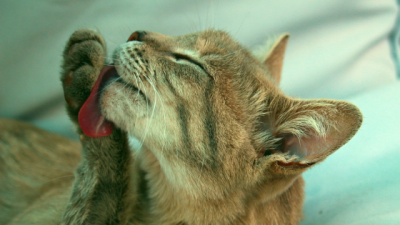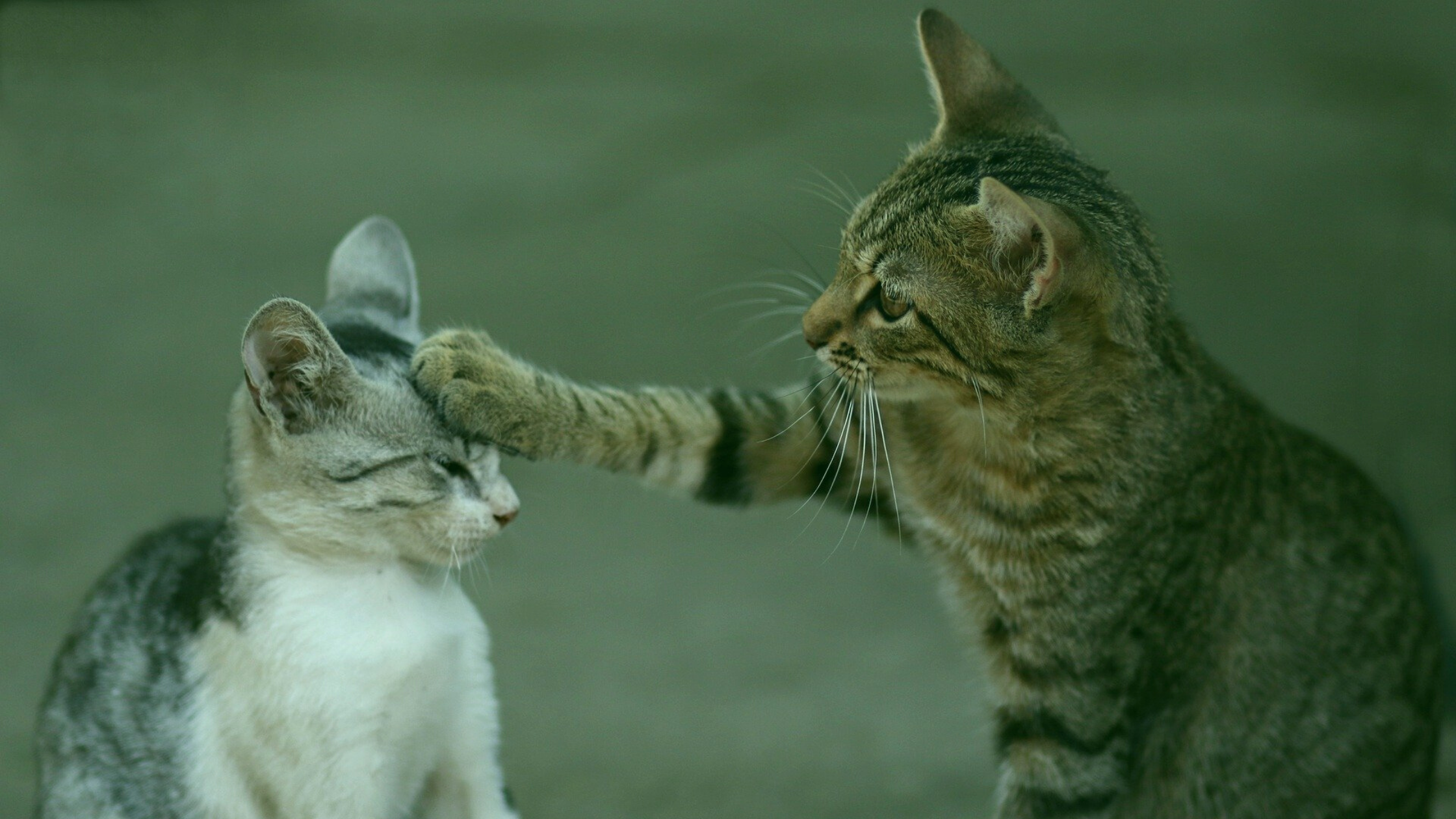Hyperthyroidism in Cats
 Hyperthyroidism, or the overproduction of thyroid hormone in the body, is a serious condition in both humans and their pets. According to the Textbook of Veterinary Internal Medicine, hyperthyroidism is a common problem in cats over eight years old and occurs much more frequently than hypothyroidism, where the body produces too little thyroid hormone. Hyperthyroidism is rarer in dogs. Studies indicate that hyperthyroidism in cats has increased dramatically in recent decades. What are the possible causes of feline hyperthyroidism, and what are the options available to treat it? Better still, are there any measures we can take to prevent it?
Hyperthyroidism, or the overproduction of thyroid hormone in the body, is a serious condition in both humans and their pets. According to the Textbook of Veterinary Internal Medicine, hyperthyroidism is a common problem in cats over eight years old and occurs much more frequently than hypothyroidism, where the body produces too little thyroid hormone. Hyperthyroidism is rarer in dogs. Studies indicate that hyperthyroidism in cats has increased dramatically in recent decades. What are the possible causes of feline hyperthyroidism, and what are the options available to treat it? Better still, are there any measures we can take to prevent it?
Diagnosis and Treatment
The College of Veterinary Medicine of Washington State University published a list of common signs of hyperthyroidism in cats:
- Weight loss
- Increased appetite
- Increased activity and restlessness
- Aggressive or cranky behavior
- A poor hair coat
- A fast heart rate
- Increased water drinking and urination
- Periodic vomiting
- An increased amount of stool or diarrhea
- Occasional difficulty breathing
- Occasional weakness
- Occasional depression
If a cat presents these symptoms, a veterinarian can test the blood for the thyroid hormone, thyroxine (T4). Excessive levels of T4 will confirm the diagnosis of hyperthyroidism.
Currently, there are three main types of treatment for hyperthyroidism:
- Lifelong use of anti-thyroid medications
- Surgery to remove the thyroid gland
- Radioactive removal of the thyroid gland
Surgery and radioactive iodine treatment are more costly than medications but are considered a more permanent solution to excessive thyroid production.
Anti-Thyroid Medications
According to Rich Gaffin, the managing pharmacist at Pet Health, methimazole is an anti-thyroid drug frequently compounded for hyperthyroid cats. Doses can be carefully chosen and monitored by the veterinarian.
Specific strengths of methimazole are prepared as capsules, liquids, or gels. Capsules tend to be the least popular, because of the skill required by the pet owner to get a cat to swallow a capsule. If a pet owner uses the liquid formulation, Gaffin recommends mixing it into a small amount of food and making sure all of it is eaten to verify the full dose has been consumed before serving the rest of the cat’s usual amount of food.
The most popular dosage form is gel, which is applied to the cat’s ear. The gel comes in an easy-to-dose, metered, twist applicator pen, allowing for accurate dosing. The transdermal gel is applied to the part of the ear called the pinna. The pinna is the hairless part inside the cat’s ear near the tip. Avoid putting gel into the ear canal and alternate ears when applying doses. Some residue from the gel will build up so it is advised to gently clean the ear with a warm, wet cloth or towel after the medication is absorbed.
Causes of Hyperthyroidism
The incidence of hyperthyroidism in cats has risen dramatically for the last three decades, according to Dr. Karen Becker, a proactive and integrative wellness veterinarian. Research suggests that flame retardant chemicals, which were introduced in this time frame, may be associated with this increase. Flame retardant chemicals can be found in house dust as well as average household items such as rugs, mattresses, and couches. Studies also show that these chemicals accumulate in cats at a much higher degree than in their pet owners. Grooming possibly increases the amount of chemicals that cats absorb, as they ingest house dust when licking their fur.
These flame retardant chemicals, polybrominated diphenyl ethers (PBDEs), as well as other industrial chemicals such as polychlorinated biphenyls (PCBs), have recently been found in fish. This finding is of concern because fish is an often-used source of protein in cat food. Cats may have more difficulty metabolizing these abnormal chemicals, therefore allowing the chemicals to accumulate. Both PBDEs and PCBs are known to be hormone disruptors.
In addition to concerns with PBDE and PCB content, Dr. Jean Hofve warns that canned cat food made of giblets, or fowl byproducts, may contain organs such as thyroid glands and liver and may contribute to thyroid overproduction. The packaging could also be harmful, as the chemical Bisphenol A (BPA) has been found in the linings of some cat food cans.
Protecting Your Cat
In addition to medications, surgery, and radiation treatments, there are also holistic approaches that may alleviate or prevent hyperthyroidism. Dr. Becker has several suggestions for protecting your cat. Be sure to provide balanced—perhaps organic—and species-specific food, avoiding a fish-based diet and soy fillers which may cause thyroid damage. The environment can be improved—not only for cats, but also for their owners—by eliminating exposure to flame retardants and even using an air purifier. By adding nutrients, making changes in diet, and providing a healthy environment, you may be able to help prevent or relieve hyperthyroidism in your cat.
- Ettinger SJ, Feldman EC, Côte E. Textbook of Veterinary Internal Medicine Expert Consult, 8th Edition. Philadelphia, PA: Saunders; 2017. http://www.animalhealthcarecenterofhershey.com/medical%20handouts/Hyperthyroidism%20in%20Cats.pdf. Accessed 11/30/17
- Washington State University College of Veterinary Medicine. Hyperthyroidism in Cats. http://www.vetmed.wsu.edu/outreach/Pet-Health-Topics/categories/diseases/hyperthyroidism-in-cats. Accessed 11/30/17.
- Personal conversation with Rich Gaffin, Managing Pharmacist, Pet Health Pharmacy.
- Becker K. Do You Feed Your Kitty This Favorite Food? 2 Reasons to Stop It Today. Healthy Pets With Dr. Karen Becker, Presented by Mercola. https://healthypets.mercola.com/sites/healthypets/archive/2016/03/14/cat-hyperthyroidism-pbdes.aspx. Accessed 11/30/17
- Hofve J. Hyperthyroidism. Little Big Cat. http://www.littlebigcat.com/health/hyperthyroidism/. Accessed 11/30/17.
Written by Carol Petersen, RPh, CNP
Edited by Laura Strommen
© Pet Health, a division of Women’s International Pharmacy, Inc.





